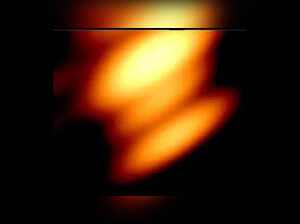Science
Finnish Astronomers Capture First Image of Orbiting Black Holes

Finnish astronomers have achieved a groundbreaking milestone by capturing the first-ever image of two black holes orbiting each other. This significant discovery offers definitive evidence that black holes can exist in pairs, as detailed in a study published on October 9, 2023, in The Astrophysical Journal.
Mauri Valtonen, an astronomer at the University of Turku, expressed excitement over this historic achievement, stating, “For the first time, we managed to get an image of two black holes circling each other.” The duo was identified through subtle variations in radio light detected by both terrestrial and space telescopes, alongside the intense particle jets they emit.
The black holes are located approximately 5 billion light-years from Earth, orbiting the core of a quasar known as OJ287. Quasars are bright galactic centers formed when massive black holes consume surrounding gas and particles. The primary black hole in OJ287 has an estimated mass of around 18 billion solar masses, while its smaller counterpart weighs nearly 150 million solar masses.
Detecting the Invisible
Despite their inherent darkness, black holes can be observed indirectly through the particle jets they emit or the glowing gas that surrounds them. Valtonen noted that OJ287 is bright enough to be seen by amateur astronomers using private telescopes. He highlighted the unique nature of OJ287, which has been suspected to host two orbiting black holes, creating a recognizable pattern of light fluctuations every 12 years.
The hypothesis regarding the presence of a second black hole was initially proposed in 1982 by Aimo Sillanpää, a student at the University of Turku, who noticed that the brightness of OJ287 varied on a decadal scale. The recent imaging serves as the first solid confirmation of this cosmic phenomenon, often referred to as a “happy hour” in astronomical terms.
To achieve this, researchers utilized a network of radio telescopes, including the Russian RadioAstron satellite, which operated from 2011 to 2019. Valtonen explained that the satellite’s radio antenna reached halfway to the Moon, significantly enhancing the resolution of the captured images compared to Earth-based telescopes.
Confirming the Twin Black Holes
By analyzing the images alongside prior theoretical predictions, scientists successfully identified two distinct characteristics corresponding to the jets emitted from each black hole. While there is a slight chance that the jets might overlap, leading to a scenario where only one black hole is visible, researchers assert that the existence of the second black hole can be confirmed through similarly high-resolution imaging techniques, such as those offered by RadioAstron.
This breakthrough not only advances our understanding of black hole interactions but also opens up new avenues for research in astrophysics. The ability to visualize and study these cosmic giants in pairs could shed light on their formation and evolution in the universe, offering profound insights into the dynamics of galactic structures.
-

 World5 months ago
World5 months agoSBI Announces QIP Floor Price at ₹811.05 Per Share
-

 Lifestyle5 months ago
Lifestyle5 months agoCept Unveils ₹3.1 Crore Urban Mobility Plan for Sustainable Growth
-

 Science4 months ago
Science4 months agoNew Blood Group Discovered in South Indian Woman at Rotary Centre
-

 World5 months ago
World5 months agoTorrential Rains Cause Flash Flooding in New York and New Jersey
-

 Top Stories5 months ago
Top Stories5 months agoKonkani Cultural Organisation to Host Pearl Jubilee in Abu Dhabi
-

 Sports4 months ago
Sports4 months agoBroad Advocates for Bowling Change Ahead of Final Test Against India
-

 Science5 months ago
Science5 months agoNothing Headphone 1 Review: A Bold Contender in Audio Design
-

 Top Stories5 months ago
Top Stories5 months agoAir India Crash Investigation Highlights Boeing Fuel Switch Concerns
-

 Business5 months ago
Business5 months agoIndian Stock Market Rebounds: Sensex and Nifty Rise After Four-Day Decline
-

 Sports4 months ago
Sports4 months agoCristian Totti Retires at 19: Pressure of Fame Takes Toll
-

 Politics5 months ago
Politics5 months agoAbandoned Doberman Finds New Home After Journey to Prague
-

 Top Stories5 months ago
Top Stories5 months agoPatna Bank Manager Abhishek Varun Found Dead in Well









